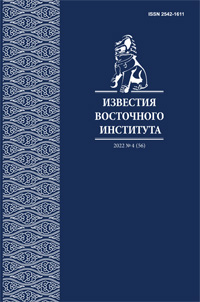Spiritual values in the festive leisure of citizens of the South of the Russian Far East (late XIX – early XX century)
DOI:
https://doi.org/10.24866/2542-1611/2022-4/38-47Keywords:
Far East, spiritual values, holiday leisure, city, cultural space, holiday, ritualAbstract
The article considers the main city holidays as spiritual values in the festive leisure of the Russian population of the Far Eastern region in the late XIX – early XX centuries. The methodological basis of the article was an extensive set of theoretical and methodological provisions for the study of holiday leisure. It is noted that among the reasonable entertainments are widely organized folk readings designed to distract people. The role of ship bands, military parades and ceremonies in the spiritual and moral education of the Far East is determined. Descriptions of New Year and Easter celebrations, all-Russian memorable dates, events of Far Eastern history, children's holidays in the system of spiritual values are revealed. It is proved that the origins of the educational impact of the holidays were in topics and problems that were significant for society. The city holiday, being one of the forms of transmission of historical and cultural traditions, representing a complex phenomenon of art, ensured the preservation of spiritual values.




